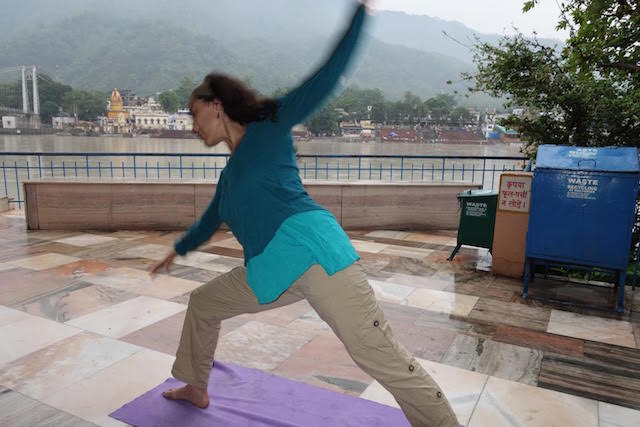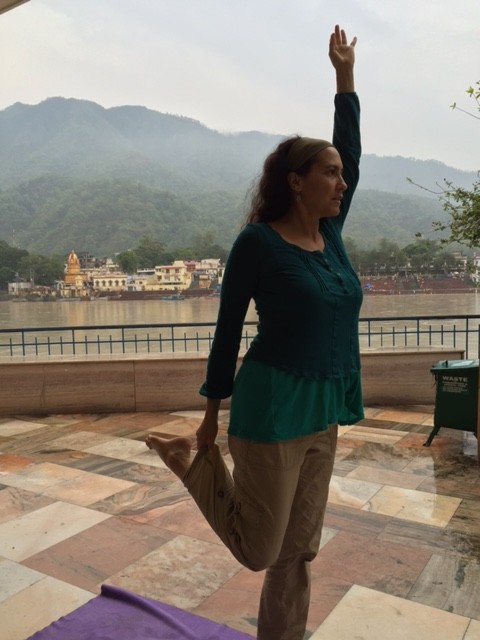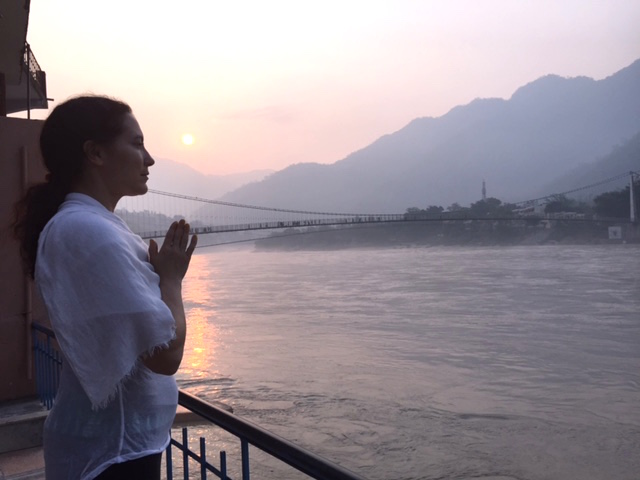I traveled through Northern India this summer with my father.
When I reached the Ganges River in Rishikesh, home to many yoga ashrams, I was captivated by the quality of the river currents as I sat and watched the river flow downstream.
The river flowed continuously—some days more rough than others—yet there was always a calmness, gracefulness and gentle flow to it as the currents passed me by. Solid earthen hills towered behind the “Mother Ganges,” as the river is endearingly called, creating a perfect balance of the elements: water, earth, fire (the sun rising behind the river) and air (the gentle breeze).
I was reminded that this is the exact quality of grace, ease and balance we can create in our own bodies, minds and lives with the practice of Hatha Yoga. In Sanskrit, Hatha Yoga translates to sun (ha) and moon (tha) union, creating balance of opposites.
While in Rishikesh, I practiced yoga daily before sunrise, as the yogis do, to maximize the energy and alignment of the sun and to achieve the calmness of the mind in the auspicious hours (amrit vela). At the Sivananda Yoga Divine Life Society ashram where I was staying, I would practice on the porch where the great yogi Swami Sivananda lived and practiced himself.
Each day, I would practice the ancient techniques of pranayama (breathing practices) for balance and energy and to prepare the mind for concentration (dharana). Afterwards, I would sit in stillness, observing the breath, heading towards a meditative state (dhyana) for inner peace, clarity and perhaps even a taste of bliss.
Then, after meditation, just as the sun was rising behind the Ganges (at the early 5:20 a.m. hour) I would start my sun salutations (surya namaskar) to warm the body up for the main yoga postures, which provide radiant health, vitality, strength and flexibility in the body and mind.
As a yoga instructor teaching daily to companies in the Bay Area, California, I was inspired to share the sequence I was practicing with my students and others, so that more people can feel their own energy flow like a river—afterwards allowing their mind to be still and calm.
“Be still like a mountain and flow like a great river.” ~ Lao Tzu
Sunrise at the Ganges River
“Flow Like a River” Hatha Yoga Sequence on the Ganges
Modify all postures so that your body is comfortable, and make sure that there is no strain or pain. Take breaks when you need (rest on your back in corpse pose, called savasana). For those needing to adapt this sequence in a chair or wheelchair, you can learn more ideas in my book, SunLight Chair Yoga: yoga for everyone!
Warm Ups (heating like the sun)
Warm up with sun salutations (surya namaskar), a series of 12 postures in sync and flowing with your breath. Try it facing the sun, outside, if you are able.
Here is a video you can use to learn the sun salutations (filmed back in California before I left for India).
Ideally you can do this at sunrise or sundown.
This is useful to increase circulation, flexibility, energy and vitality at any time of day.
Standing Flow Sequence (moving like a river)
These standing postures increase leg strength, opens the hips, bring stability and balance to the body and mind and stretches the back. You can flow from one posture to the next, or take breaks in between by pausing in mountain pose (tadasana), standing with your feet together and balancing the weight on both feet.
Warrior Posture (Virabhadrasna)

Place your feet three to four feet apart. Bend your front leg and keep the back leg straight, pressing the back heel and foot evenly into the earth. Turn the hips and torso to face the front leg. Stretch the arms up overhead and if able, place the palms together, while you keep the face and shoulders relaxed.
Focus the eyes in front of you on one point or gazing skywards, towards the hands.
Hold for three to five slow, deep breaths.
Feel your strength, focus and determination as a peaceful warrior, as you ground your feet into the earth while lifting your heart up to the heavens.
Alignment tips:
~ Make sure that the front knee does not go past your front heel.
~ Evenly press the inner and outer heels of your back foot into the ground.
Modify the shoulders and arms by keeping the hands shoulder width apart overhead as needed, or bring the hands out in front of you instead of overhead.
Benefits: Increases leg strength, balance, supports the knee joints, and mentally brings joy, positivity, focus, determination and confidence.
Warrior Pose: Hip and Shoulder Opening Variation

From Warrior Pose, interlock the fingers behind you. Inhale as you lift the heart up towards the sky and simultaneously stretch the hands towards the earth (this opens the chest, upper back and shoulders). As you exhale, bend at the hips and relax the crown (top) of the head toward the inside (big toe side) of the front foot.
Keep pressing the back foot evenly into the earth as in Warrior Pose. Hold for three to five slow, deep breaths. To come out of the posture, ground the back foot (press it into the earth), inhale as you rise back up to Warrior Pose. Repeat on the second side or continue with the next few poses as a flow sequence by keeping the same foot forward for all postures.
Repeat the whole sequence on the other side.
Yoga practice, just like life, is full of options. You can also flow back and forth between the two postures in the photos above. For example, inhale to Warrior Pose, and then exhale in to the hip and shoulder opening variation.
Repeat three to five times, keeping both feet rooting into the earth.
Intense Side Stretch Pose (Parsvottanasana)

Place your feet three to four feet apart. Straighten your front leg. Inhale as you stretch the arms up towards the sky. Exhale and stretch the spine away from the hips and towards the front leg. Then release the hands to the front leg or floor along side the legs or feet (you can also use two yoga blocks to support the hands or place the hands on a chair or table out in front of you). Hold and breath for three to five slow, deep, rhythmic breaths. Relax into the pose.
Modify the posture by bending the front leg slightly, as needed so that there is no strain.
Benefits: This posture stretches the legs, hamstrings and spine (good for runners and athletes).
Extended Side Angle Pose from Warrior II

From Warrior Pose open the hips to face forward (no longer towards the front thigh). Stretch the arms in, away from the heart (in a T shape). You can hold there (Warrior II Pose) for three to five slow, deep breaths. As you exhale stretch the spine over your front (bent knee) leg, while keeping the chest facing forward.
Release the front hand to rest on the front thigh or floor (in front or behind the front leg). Hold for three to five slow, relaxed breaths. Keep the weight even on both feet. To come out of the posture, press your back foot into the earth and inhale to rise up back to Warrior II (you can also repeat the sequence again if you want a more vigorous practice).
Reverse Warrior Pose

From Extended Side Angle, go back into Warrior II Pose (arms stretch out in a T shape). Place your back hand on the back thigh (or outer shin) as you exhale, while you stretch the top arm over the top ear, creating a crescent moon shape or gentle curve with your spine. Keep the weight even in both feet as in Warrior I and hold for three to five slow deep breaths. Inhale to come out the posture.
Rest in Mountain Pose (tadasana) with your feet together as you evenly distribute the weight between both feet. Pause and feel the effects of the standing postures.
Seated Postures (rooting like a mountain)
Wide Leg Seated Forward Bend

Stretch your legs apart, as wide as comfortable, without causing strain. Press the top back of each thigh evenly into the earth. Sit on a cushion or folded towel as needed to support the back. Inhale as you stretch the arms overhead. Exhale and fold forward placing your hands on the floor, thighs, holding the big toes or using yoga blocks in front of you (for more support).
Alignment tips:
~ Do not let the buttocks or thighs lift off the floor.
~ Keep the middle of the knees and middle toes facing skywards.
Seated Side Bending from Wide Angle Pose

Stretch your legs apart, as wide as comfortable, without causing strain. Press the top back of each thigh evenly into the earth. Sit on a cushion or folded towel as needed to support the back. Inhale as you stretch the arms overhead. Exhale and gently curve the spine to one side, placing the bottom arm in front of the thigh (or resting it on a yoga block for more support). As a modification you can also place the bottom hand on the floor.
Gently turn the spine and chest towards the sky, allow the neck to follow and look towards the top arm. (If there is any strain in the neck, look forward or down instead.) Hold for three to five slow breaths. Switch sides.
Alignment tips:
~ Only bend sideways as far as comfortable, while keeping both thighs and buttocks evenly pressing into the earth.
~ Have all the toes facing skywards (do not let the legs roll outwards).
Benefits: Stretches the legs, side body and opens the side ribs to give a feeling of expansion and more room to breath easily and freely. This lateral bend increase flexibility of the spine and legs.
Wide Leg Seated Spinal Twist

Stretch your legs apart, as wide as comfortable, without causing strain. Press the top back of each thigh evenly into the earth. Sit on a cushion or folded towel as needed to support the back. Inhale as you stretch the arms overhead. Exhale and gently twist to one side while keeping the spine lengthening skywards. Place one hand behind you and one hand in front of you as in the photo below. Inhale as you sit tall, and exhale as you twist. Repeat for three to five slow, deep breaths and then switch sides.
Benefits: Helps the digestive organs, eases back tension and calms the nerves.
Standing Balance Pose
Now that you created flexibility, balance, stability and strength in the body and mind you can end with a one legged balance posture to improve your mental concentration.
Natarajasana in Sanskrit is the cosmic dancer. This is symbolic of the dance of the soul: birth, life, transformation or death (or what the dance of life means to you). In this posture you can find stability and also have some fun in the process. If you fall or don’t feel very graceful, that too is a dance, so enjoy it!
Benefits: helps improve your concentration and focus. This posture also creates balance in the body and helps bring stability to the joints and is an upper back and shoulder opener (backbend). Symbolically this pose can help your find ease and balance even in the constant movement of life.
Cosmic Dancer Pose (Natarajasana)

Balance on two feet. Shift the weight to one foot.
Hold on to one foot or as a modification you can hold onto your pants or use a yoga belt as in the photo below.
As you hold the foot or pants, lift the back foot up and press it back away from the body. While you do this stretch the other arm overhead, placing the upper arm by the ear, or even moving the arm towards the back of the head. Find your breath and breathe into the opening and expansion of the chest and upper back.
Cosmic Dancer Variation

Tilt the pelvis forward trying to keep the back thigh lifting in line with the front arm ahead of you. Do your best to create a parallel line between the back thigh and front arm. Hold for three to five slow deep breaths while keeping the eyes focused on one point in front of you. Inhale and slowly ease out.
Switch sides.
Final Relaxation
Lie on your back. Have the feet be two to three feet apart, and the arms be a few inches from your hips with the palms facing skywards. Relax in Corpse Pose (savasana) for 10 minutes. Observe each part of the body relax. Then watch the breath and allow all thoughts to flow in and out, just like currents in a river. Be a silent witness to the relaxation process. Let the mind rest deep within. Enjoy the deep stillness and peace beneath and between the waves of the mind.
To come out of savasana bring the knees into the chest, roll to the right side and pause. Slowly push off your hands to ease yourself sitting upright in a cross legged seat.
Meditate on the breath for two to 31 minutes.
Chant three “AUMS” ॐ as you focus at the point between the eybrows.
Namaste.
Author: Stacie Dooreck
Editor: Renée Picard
Images: via the author













Read 1 comment and reply